
Light Polarization
 |
| Figure 2: Wave nature of light |
It is easy to visualize a light ray as a stream of particles (called photons). But, did you know that light can also be described as waves? In fact, a single photon can be considered as two waves of electric and magnetic fields − one perpendicular to the other [1]. Figure 2 shows a light wave with its electric and magnetic components. In Figure 3a, the illustration of a light wave is made simpler by showing just its electric field.
 |
| Figure 3: Polarized and unpolarized light |
A light source like an electric bulb contains a large number of molecules that emit light. If the orientations of the electric fields produced by these emitters are the same, then we say the light is polarized [2]. The single light wave shown in Figure 3a is of course polarized. The direction of polarization (or polarity) is said to be along the plane of the electric field. In most cases, however, the electric fields emitted by the particles are not aligned. That is, the light is composed of many light waves with electric fields in practically every direction. In Figure 3b, the light is composed of two waves with perpendicular electric fields. Such light has no single polarity and is said to be unpolarized.

 References
References







 References
References